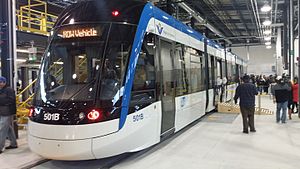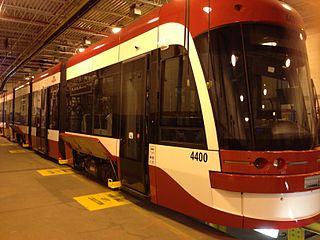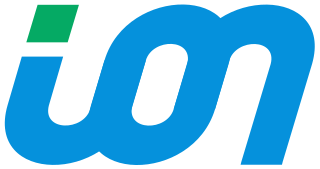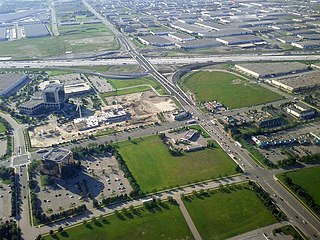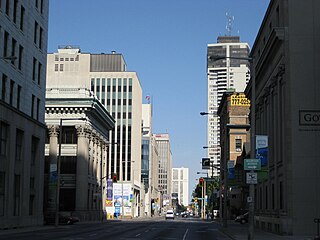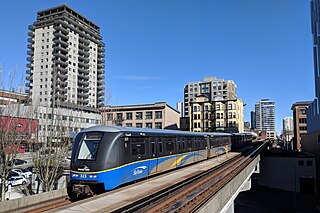Delivery
The Flexity Freedom cars were designed for the Transit City plan which would have created six suburban LRT lines for an order of about 300 cars. Only two of these projects were active in 2016: the Eglinton Crosstown line, the first to go into construction, and the Finch West LRT, which was approved later. Metrolinx placed its first order for 182 vehicles [11] [12] under a CA$770-million contract announced in 2010. Of the 182 vehicles ordered, 76 were for the Eglinton Crosstown line and 23 for the Finch West LRT. [13] Bombardier expected deliveries to start in 2018. [14]
By May 2016, Metrolinx had not received the prototype vehicle that Bombardier was supposed to produce by spring 2015. The prototype, once received, would be tested for one or two years to work out any design bugs before Bombardier begins to manufacture the rest of the order. [15]
In July 2016, Bombardier spokesman Marc-André Lefebvre acknowledged receipt of "a contractual notice" from Metrolinx complaining about the delay in delivery of the prototype vehicle. Lefebvre said that the prototype would be delivered in August giving Metrolinx 18 months to test the vehicle, about double the time needed for testing. Lefebvre also said production would begin in spring 2018 and the remainder of the 182-car order would be delivered in time for the scheduled opening of the line. [16] On September 1, 2016, Bombardier said the prototype was nearing completion at the Thunder Bay plant and would be available for testing in 3–4 weeks. [17]
In September 2016, the province allowed consortia to include the delivery of light-rail vehicles in their bid to build the Finch West LRT, implying it might not use Flexity Freedom vehicles. Metrolinx was also considering such an approach for its two LRT projects outside of Toronto: the Hurontario LRT and the Hamilton LRT, [18] the latter cancelled by the province in December 2019 due to cost. [19]
In November 2016, Metrolinx gave formal notice of intent to cancel its contract with Bombardier. [20] Metrolinx alleged unacceptable delivery delays fearing that the opening of the Eglinton Crosstown line would be delayed due to a lack of vehicles. Bombardier claimed it could complete the order on time. [21] Metrolinx also alleged that the prototype could not handle basic functions such as taking power from an overhead catenary. Bombardier claimed the prototype functioned properly, and that it was conducting static tests before doing moving tests with power taken from a catenary. [22]
In late November 2016, Bombardier shipped the first pilot vehicle from its Thunder Bay plant to its Kingston plant to continue testing. The vehicle was still expected to require nine months of qualification testing. [23] [24]
By 2016, Metrolinx had inspected Bombardier's plants several times in both Thunder Bay, Ontario, and Sahagun, Mexico, and concluded that quality control was "plagued by welding issues as a result of poor training, incorrect procedures, faulty equipment and poor management". Metrolinx also discovered that quality control standards were inconsistent between the two plants. Bombardier acknowledged the problems but claimed they had since been resolved. [25]
On March 2, 2017, Metrolinx filed court affidavits to support its action to terminate the Flexity Freedom contract due to high financial risks. If Bombardier failed to deliver on time, Metrolinx would be liable to pay Crosslinx Transit Solutions, the consortium building the Crosstown, $500,000 per day [25] while Bombardier would be liable to pay only $1,500 per day per late vehicle. [26]
After Metrolinx failed in its court action against Bombardier, it announced on May 12, 2017, that it had signed an order for 61 light rail vehicles with Alstom, a competitor of Bombardier. If Bombardier delivers the Flexity Freedom vehicles on time to service the Eglinton Crosstown line, then Metrolinx will assign 17 Alstom Citadis Spirit LRVs to the Finch West LRT and 44 to the Hurontario LRT. However, If Bombardier is late in delivery, the Alstom units will serve the Eglinton Crosstown. [27]
On December 21, 2017, Metrolinx [28] and Bombardier [29] announced an agreement to reduce the Metrolinx order for Flexity Freedom vehicles from $770 million for 182 vehicles to $392 million for 76 vehicles, enough to supply only the Eglinton Crosstown line. The agreement also increased the potential penalty against Bombardier for late deliveries. In exchange, Bombardier received an 18-month extension on their contract to operate and maintain GO Transit rail services on behalf of Metrolinx. [30] [26]
In late October 2018, the first vehicle arrived in Kingston for testing and was scheduled to be delivered to Toronto in November, followed by five more cars by February 2019. [31] [32] The first Flexity Freedom vehicle arrived on January 8, 2019, at the Eglinton Maintenance and Storage Facility. [33] On February 1, 2019, Metrolinx announced that Bombardier had missed the deadline to deliver the first six vehicles. [34]
On November 26, 2019, Metrolinx made an order modification with Bombardier to add communication and signalling equipment to the vehicles. The order change would cost $36.2 million plus $3 million if Bombardier completed the work on time plus $1.5 million to transport the vehicles to Bombardier's Thunder Bay plant. Crosslinx Transit Solutions was responsible for designing the communication and signalling systems, which it completed late. Vehicles already manufactured needed to be retrofitted. [35]
The due date for the acceptance of the first six vehicles is July 1, 2020. Line 5 Eglinton requires only 42 of 76 vehicles ordered for opening day (sometime in 2022), but Metrolinx expects the first 42 to be delivered by August 1, 2021. The deadline for the balance is March 31, 2022. By mid-March 2020, Bombardier had manufactured 30 vehicles, of which Metrolinx has given final acceptance to two. [35]
